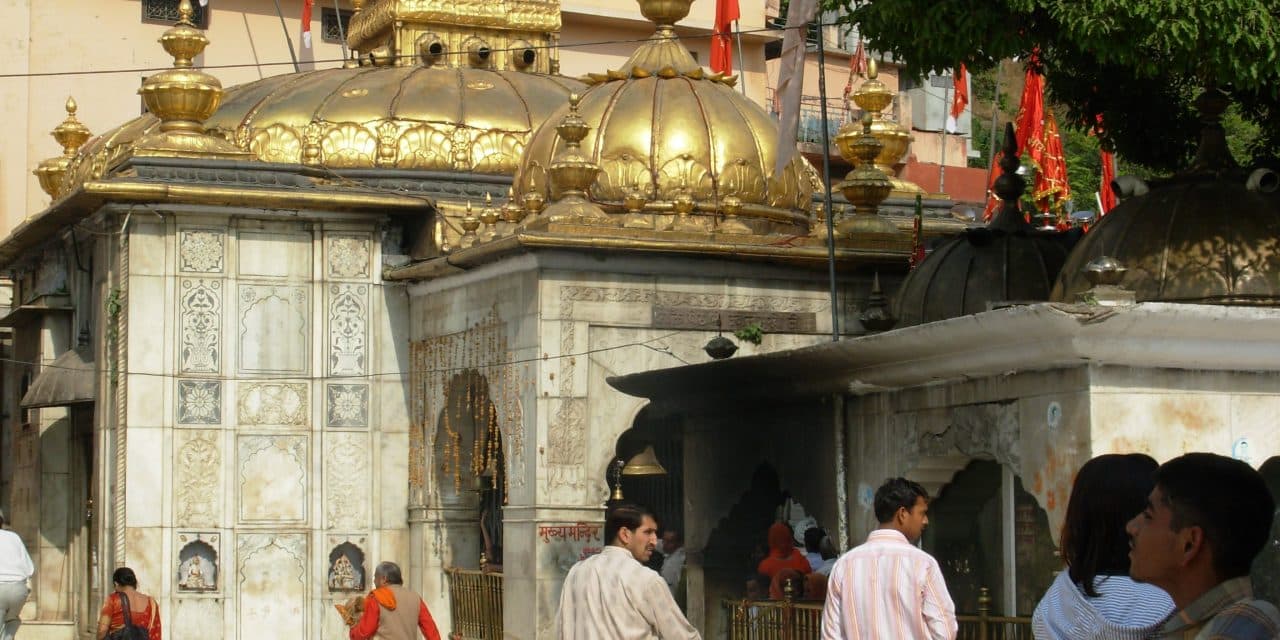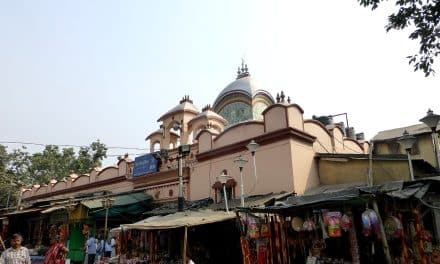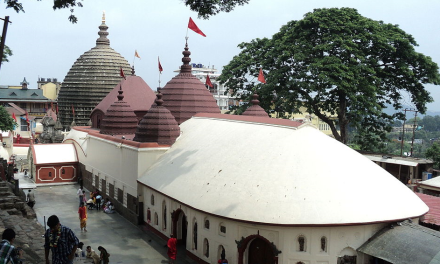One of India’s most miraculous and deeply revered Shaktipeethas, popularly and widely known as Jwala Ji or Jwala Devi Temple. It is famous due to its unique posture of tiny flames, which have mythological and scientific significance. This temple does not house any idol or image. Goddess Jwala Ji has Her abode in the Shivalik range’s lap, 35 km(30 km) south of Kangra valley called ‘Kalidhar’, located in Jwalamukhi tehsil, district Kangra in Himachal Pradesh. This temple is situated in an area of natural beauty under the Dhauladhar range and is set amidst undulating hills. It is also about 56 km from Dharmasala and 140 km from Pathankot via Dharmasala. This Shaktipeetha also has its fame as ‘Jota Wali Temple’. This temple is submitted to the Goddess Jwalamukhi, the deity of the flaming mouth or the mouth of a volcano. Hence, the Goddess is called ‘the Goddess of Light’, ‘the Flaming Goddess or ‘She of the Flaming Mouth’. As per Hindu mythological scripture, when Lord Vishnu disjoined the corpse of Devi Sati, it is believed that the tongue of Hers fell here, and at this very place, the temple had been erected later. The tongue of Devi Sati here is a relabel of holy flames continuously burning and worshipped as ‘Siddhida'(Ambika) with devotion by the devotees, where Lord Shiva as ‘Unmatta Bhairav’ or ‘Manikat’ to protect his consort.
Myth for the emanation of the flames: The legend attained the belief of the Hindus as two demons Chand and Mund, who looted all the wealth of Devas. The Devas were plunged into sorrow and uncertainty. All the Devas then unanimously decided to take recourse to Lord Shiva, the lord of the universe. They successfully satisfied him through their long and intense penance for getting back their wealth. He, the lord, then appeared before them and assured them that the Divine Mother would appear in flames and help them. The place was that cave on a hill where the demons hid the looted wealth. Mother Jwalamukhi had appeared on that hill and annihilated the above-mentioned two demons taking away all the wealth of the Devas with Her. But it was not all for the incident that would end. The Goddess decided to reside here in this form, and She is being worshipped here in the form of a yantra(diagram) or in the form of flames which come out from the crevices of the rock. Another belief is very traditional that Jwalamukhi represents the flaming mouth of Jalandhara(exceedingly powerful and considered one of the mightiest demons of all time), who was crushed to death by Lord Shiva, and the amazing flames came from his mouth.
Science has a concrete explanation to counter this traditional myth. The temple consists of a copper pipe from which natural gas is emitted from nine different locations(nine fissures symbolize the nine forms of Divine Mother in various incarnations as Mahakali, Annapurna, Chandi, Hinglaj, Bindhya Basini, Maha Lakshmi, Saraswati, Ambika and Anji Devi or Anjana). Priests of the temple lit it to produce a flawless blue flame.
The history behind its erection: Raja Bhoomi Chand Katoch of Kangra, a great devotee of Goddess Durga, dreamt of a sacred place and ordered his soldiers to find the whereabouts of the same where the first construction of this temple was started. It was 1815(it may be in 1809) when Maharaja Ranjit Singh of Punjab paid a visit to this temple. He gold-plated the dome, and a pair of silver-plated folding doors was gifted by Kharak Singh, the son of Maharaja Ranjit Singh, where it is said that the present temple was completed in the year 1835 by him. However, Raja Sansar Chand of Himachal Pradesh had a role in erecting this temple. The Mughal emperors Akbar and Jahangir also visited this temple to test its originality. This is believed that the Jwalamukhi Temple is the first ever temple built by the Pandavas, or they have seen this sacred place. Dhyanu Bhakt, an ardent devotee of the Goddess Jwala, lived near Delhi during the time of Akbar and is credited with popularising the divinity of this shrine.
History also encloses to its record as a heresy that emperor Akbar tried to extinguish the flames with a stream of water channelized. However, it was astounding for him that the flames were still burning, which was ample evidence of the great power of the Goddess Jwala. Since then, Akbar has become an ardent devotee of Jwala Devi, acknowledging her power. As a result, he offered the Goddess a gold umbrella carried away by his army to the temple. But there was another surprise waiting for him. The golden umbrella soon after the offering was converted into copper because Goddess declined him. Today the stream is still flowing within the temple premises.
Temple’s architecture: The structural design of the shrine is simple, and it is built on a wooden platform representing the ‘Indo-Shikh’ style of architecture(developed under the Shikh Empire during the 18th and 19th centuries). Shikh architecture was distinguished three hundred years ago for its many curves and straight lines. Mughal and Islamic styles heavily influence it). The temple’s architecture consists of a dome and several pinnacles. The dome and spire are gilded with gold, and the main door is beautifully made of silver plates. At the entrance, there are two lion statues.
A small platform is in front of the temple before entering a large mandap(hall). A big brass bell is hung and beautifully adorned, gifted by the King of Nepal.
A pit has been measured as 3 feet square and 6 feet deep, situated in the centre of the temple in between the floor pillars supporting the roof and having pathways all around it symbolizes the path for happier days to come, and this is considered as the mouth of the Mahakali Goddess. This wonderful pit is perpetually and endlessly burning, where the primary flame is positioned in the central square pit of hollowed stone. It is a belief that the flames from the pit represent the deity and symbolize her power as the all-consuming energy which purifies the soul and leads to the end of struggles. A musical fountain is also situated near this temple which becomes colourful and delightful at night.
About offerings, worshippings and Aartis of the temple: To have blessings of the deities, offerings, and prayers are standard practices by the devotees. Here in this temple, milk and water are usually offered to the deities. The ahutis(offerings made to deities during a ritual fire ceremony. Ahuti is an important part of Agnihotra, Yajna and other Vedic rites as described in ancient Vedic texts, such as Brahmanas) or oblations are offered to the sacred flames in the pit. The deities also offer a Bhog of Rabri(thickened milk), Misri or Candy, and seasonal fruits.
A mystic ‘Yantra'(diagram) of the Goddess is inside the sanctum, which is covered with shawls, and ornaments and hymns are uttered with devotion by the priests. The puja is performed here daily in different phases throughout the day. Aarti is performed in this temple five times in the day, havan(a ritual burning of offerings such as grains and ghee, held to mark births, marriages and other special occasions) is performed once daily and portions of ‘Durga Saptasati'(The Devi Mahatmya or Devi Mahatmyam is a Hindu philosophical text describing the Goddess as the supreme power and creator of the universe. It is a part of Markandeya Purana. Devi Mahatmyam, also known as the ‘Durga Saptashati’) is recited.
Here in this holy place, the ritual ‘Aarti’ is performed with pomp. The Goddess Jwala Ji receives Her first Aarti of the day early at 5:00 a.m., with the name ‘Mangal Aarti’. The next proceeds at sunrise, known as ‘Panjupchaar Pujan’. Another is held around mid-noon, called ‘Bhog Ki Aarti’. The evening Aarti is celebrated at around 7:00 p.m. The last one is held at around 10:00 p.m., known as ‘Shaiyan Ki Aarti’ and is exclusively unique as it is performed nowhere except in this temple. It is conducted in two parts with shlokas(hymns) from ‘Soundarya Lahri'(meant as ‘The Waves of Beauty’ is a famous literary work in Sanskrit attributed to Adi Shankara. Some believe the first part ‘Ananda Lahari’ was engraved on mount Meru by Ganesha himself) being recited during this Aarti time. While this Aarti is carried out, the bed of the Goddess is decorated with beautiful dresses and pieces of jewellery.
Festivals: Two huge fairs are held at this temple in the Bengali Hindu months ‘Chaitra'(March to April) and Ashwin(September to October), respectively. Some important attractions of these two fairs are folk dances, songs, plays, wrestling matches and athletics.
Visiting time: Every day of the week, the devotees and the tourists can have their darshans of the deities from 5:00 a.m. to 12:00 p.m.(first shift) and from 4:00 p.m. to 8:00 p.m.(second shift).
Postal address: Jwala Ji Temple Road, Kohla, Jwalamukhi, Himachal Pradesh.
Contact number: 01970222223.
How to reach: Three means of communication are activated toward the temple as follows:
By Air: The nearest airport to Jwalamukhi Temple is Gaggal Airport(also known as Dharamsala Airport) in Kangra Valley, which is about 46 km from Jwalamukhi. This airport connects domestic flights to Delhi(or connects three airports, i.e. Delhi-465 k.m. to 475 k.m. away from Dharamsala; Chandigarh- 200 k.m. away from Dharamsala and Kullu- 250 k.m. away from Dharamsala). International travellers have to connect through Delhi Airport. Delhi Airport is well-connected to all major cities in India and abroad.
By Railway: The nearest railway station is Kangra Mandir(2 km away from Jwalamukhi Temple), but all trains do not halt here. The nearest railhead is Pathankot which is 85 km away from Dharamsala(nearly 20 km from Jwalamukhi Road Railway Station) and about 122 km from the temple. Pathankot is well-connected to all major cities in India.
By Road: Roads connect this shrine from Delhi, Chandigarh and Dharamsala. Taxis can be hired from these places. State transport bus service is available from all important cities of Punjab, Haryana, New Delhi and J&K.
Image courtesy: Nswn03

















